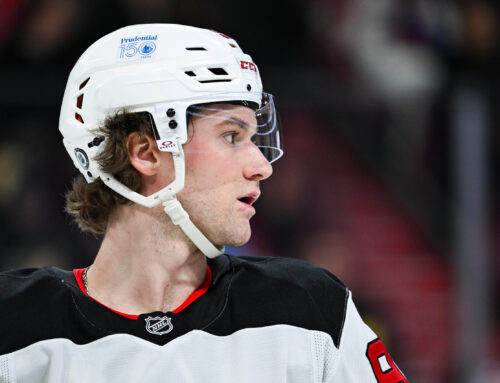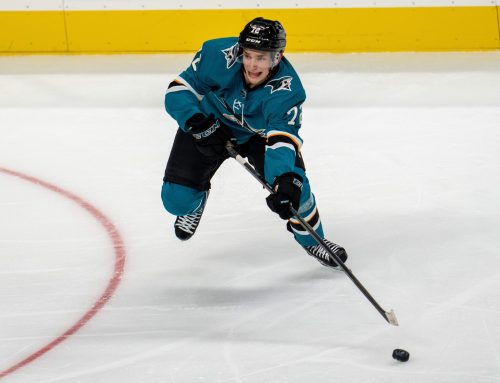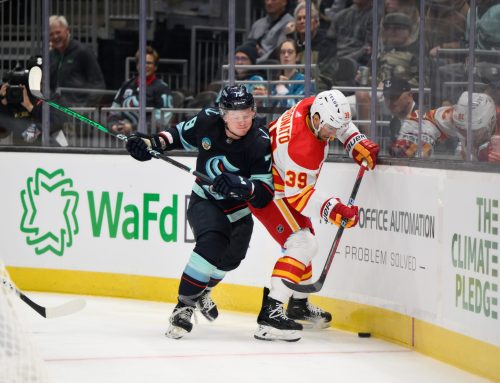
In this week’s installment, we get fancy with a few fancy stats. While some of you might be well versed in the math behind hockey, we’re going to keep it relatively simple for my simple mind. We show PDO some PDA, but instead of diving too deep into the numbers, we’ll just consider a PDO much greater than 1000 to mean there was some luck behind a player’s production, and if it’s much less than 1000, luck should start going their way as the season continues.
Sven Baertschi – Bo Horvat – Brock Boeser
Team ES Point Production: 56 | Line ES Point Production: 17 (30% of team)
Who’s the Boest player on this line? I’ll let you decide.
Who has the most points on this line? Brock Boeser.
Vancouver’s first-round pick of the 2015 draft put up 94 points in 74 games for the University of North Dakota before making the jump to the NHL. An early contender for the Calder (don’t worry Clayton Keller, I haven’t forgotten about you), none of Boeser’s advanced stats scream regression. A 5on5 shooting percentage of 7.14 isn’t out of the ordinary, and while his overall shooting percentage (14.7%) is slightly high, a 960 PDO shows luck wasn’t the driving force of his production. Here’s to another exciting rookie scoring race!
Entering his fourth season in the NHL (did somebody say year four break out?!?!), Bo Horvat’s start to the season has been Bo-tiful (11 points in 13 games). He is embracing the role of first-line center on a team that didn’t seem fantasy relevant at the beginning of the year, ranking among the top 15 (12th) in faceoffs won so far. While Boeser and Horvat’s ownership is on the rise (45% and 36% respectively), they might still be available in your league, so get on that!
To me, Sven Baertschi is the least exciting piece of this line, but that doesn’t mean he can’t be valuable in deeper leagues. Baertschi was once a first-round pick (2011), and while that seems like forever ago, it reminds us he’s not coming out of nowhere. Despite being 25 years old, Baertschi has only seen a significant number of games played in the past two seasons, beside the aging Sedins. Unlike a lot of lines, this trio sticks together on the power play, so their chemistry keeps on developing.
Zach Hyman – Auston Matthews – William Nylander
Team ES Point Production: 81 | Line ES Point Production: 19 (23 % of team)
Obviously, this was one of the hottest lines to start the season, but I wanted to wait until we had a larger sample size to take a look at their stats. The Leafs went through a bit of a rough stretch, losing five of their last six games, giving us a more accurate set of numbers to work with.
While the team struggled, it seems someone forgot to tell Auston Matthews about the sophomore slump, and he’s just running around scoring 18 points in the first 15 games of his second year in the big leagues. You don’t need me to tell you how talented he is, but the advanced stats do point at a bit of regression. Last year he finished with a PDO of 1002 and 5on5 shooting percentage of 7.72%, this season that PDO is looking pretty high at 1118 and his 5on5 shooting percentage has almost doubled (14.71%). It would seem luck has been a factor in Matthews’ super-hot start, but that doesn’t mean his production is going to fall off a cliff.
While William Nylander is maintaining the 0.75 point per game pace he set last year, his 6% shooting percentage looks unsustainably low. He already has 50 shots this season, and is on pace to surpass his 200 shot total of the 2016-2017 season (on pace for 256). As long as he keeps putting the puck on net, expect Nylander to light the lamp a little more often than he has been.
Like a lot of the lines we’ve covered in this series, this one is a dynamic duo plus-one. Unfortunately, that plus-one, Zach Hyman, doesn’t benefit greatly from his line mates’ production. Despite spending most of his time alongside Matthews last season, Hyman only had 28 points to show for it. However, his presence hasn’t hindered Matthews’ or Nylander’s production, so maybe it’s a perfect fit all around.
James Neal – Cody Eakin – David Perron
Team ES Point Production: 64 | Line ES Point Production: 16 (25% of team)
Let me throw a few numbers at you quickly. 990 PDO, 6.72 5on5 SH%, 11.4 SH%. Remember those numbers, or read them again if you need to.
Now let me throw some more numbers at you. 1039 PDO, 12.7 5on5 SH%, 21.6 SH%.
That first set of stats is from James Neal’s 2016-2017 campaign, and the second set represent his stats so far this season. The important thing to note here is how much better this year’s stats are compared to last. What does that mean? Regression.
In his first nine games, Neal put up 10 points. In his last four games, he has one assist. Obviously, it’s a new situation for Neal in Vegas, and the Golden Knights just keep surpassing our expectations. However, now that a favourable schedule to start the season (seven of first nine games at home) is in the past, expect to get a more realistic idea of the production we should expect from this team.
Cody Eakin’s numbers, on the other hand, haven’t been unsustainable, but that’s because they haven’t been very good. To put things into perspective, Eakin’s career high has been 40 points, a half-point-per-game season would be considered a success. Despite being on a new team, Eakin’s ice time hasn’t changed very much so don’t expect too much from him this season.
Finally, we turn to David Perron, who has been relatively productive (five points in his last five games). He’s seeing much more time on the power play in Vegas than he has in recent years (3:23 as opposed to 2:07, 2:04), so maybe 50 points is attainable this season.
Kyle Connor – Mark Schiefele – Blake Wheeler
Team ES Point Production: 54 | Line ES Point Production: 16 (30% of team)
Mark Scheifele has developed into one of the league’s top centers, and continues to prove that the 82 points in 79 games he totalled last season is to be expected, not considered an exception. Although his 30.8% shooting percentage is going to lower as the season progresses, there’s no reason Schiefele can’t maintain a point-per-game pace, especially playing beside high-quality players like Blake Wheeler.
Speaking of the 31-year-old winger, since arriving in Winnipeg he has consistently broken the 60-point barrier (not including the 2012-2013 lockout shortened season) and proven to be one of the best at his position.
The third member of this line is probably the one you’re least familiar with: Kyle Connor. Drafted 17th overall by the Jets in 2015, the young forward has five points in eight games so far this season. He had 44 points in 52 AHL games last season, but as long as he remains in Winnipeg’s top six, playing with the likes of Blake Wheeler, Mark Schiefele, Patrik Laine, Bryan Little, and Nikolaj Ehlers, he should be fantasy relevant. Keep in mind that Connor’s spot in the NHL isn’t guaranteed, and as Winnipeg’s players return from injury, he might get send down again.





 DAL
DAL WPG
WPG TOR
TOR EDM
EDM WSH
WSH ANA
ANA NYR
NYR CAR
CAR COL
COL
